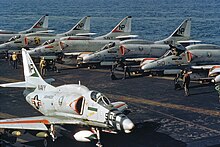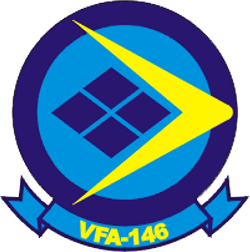
Strike Fighter Squadron 146 (VFA-146) also known as the "Blue Diamonds" is a United States Navy operational fleet strike fighter squadron based at Naval Air Station Lemoore California. They fly the F/A-18E Super Hornet and are attached to Carrier Air Wing 17, deployed aboard USS Nimitz. Their tailcode is NA and their radio callsign is Diamond.

Strike Fighter Squadron 94 (VFA-94), also known as the Mighty Shrikes, is a United States Navy fighter squadron stationed at Naval Air Station Lemoore. It is an operational fleet squadron currently flying the F/A-18F Super Hornet. It is attached to Carrier Air Wing 17 and based at NAS Lemoore, California. Its tail code is "NA" and its radio call sign is "Hobo".

Strike Fighter Squadron 113 (VFA-113), also known as the "Stingers," is a United States Navy strike fighter squadron based at Naval Air Station Lemoore, California. They are an operational fleet F/A-18E Super Hornet squadron attached to Carrier Air Wing 2 (CVW-2) and based at NAS Lemoore, California. Their tailcode is NE and their radio callsign is Sting.
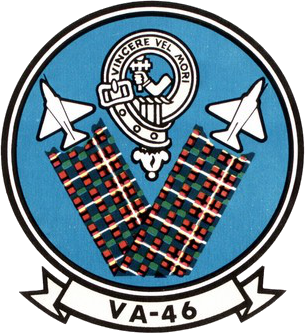
Attack Squadron 46 was an attack squadron of the United States Navy that was active during the Cold War. VA-46 was deactivated as part of the post-Cold War drawdown of forces on 30 June 1991.

Attack Squadron 75 (VA-75) or ATKRON 75 was an attack squadron of the United States Navy that was active from World War II through the 1990s. Nicknamed the "Sunday Punchers," they were based out of Naval Air Station Oceana, Virginia. Originally established as Bombing Squadron EIGHTEEN (VB-18) on July 20, 1943, it was redesignated Attack Squadron VA-7A on 15 November 1946, redesignated Attack Squadron VA-74 on 27 July 1948, redesignated Attack Squadron VA-75 on 15 February 1950 and disestablished on February 28, 1997. They were the second squadron to be designated VA-75, the first VA-75 was disestablished on 30 November 1949. They were the first fleet squadron to operate the A-6 Intruder and the last unit to fly it in operational service.

VA-55 was an Attack Squadron of the U.S. Navy. It was established as Torpedo Squadron VT-5 on 15 February 1943, redesignated VA-6A on 15 November 1946, and finally designated VA-55 on 16 August 1948. The squadron was disestablished on 12 December 1975. It was the first squadron to be designated VA-55, the second VA-55 was established on 7 October 1983 and disestablished on 1 January 1991.
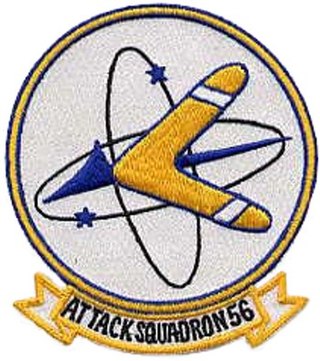
VA-56 was an Attack Squadron of the U.S. Navy. It was established on 4 June 1956, and disestablished thirty years later, on 31 August 1986. The squadron's nickname was the Boomerangs from 1957 to 1958, and the Champions thereafter.

Attack Squadron 72 (VA-72) was an aviation unit of the U.S. Navy. It was established as Bomber Fighter Squadron 18 (VBF-18) on 25 January 1945. The squadron was redesignated as Fighter Squadron 8A (VF-8A) on 15 November 1946, as VF-72 on 28 July 1948, and finally as VA-72 on 3 January 1956. It was disestablished on 30 June 1991.

VA-76 was an Attack Squadron of the U.S. Navy. It was established on 1 June 1955 and disestablished on 30 September 1969. The squadron was nicknamed the Spirits, from its motto Fighting Spirits of 76.

VA-144 was an Attack Squadron of the U.S. Navy, nicknamed the Roadrunners. It was established as VA-116 on 1 December 1955, and redesignated VA-144 on 23 February 1959. The squadron was disestablished on 29 January 1971.

Attack Squadron 145 (VA-145) was an aviation unit of the United States Navy, nicknamed the Rustlers from 1951-1954, and the Swordsmen thereafter. The squadron was established as Reserve squadron VA-702 on 1 December 1949, and called to active duty on 20 July 1950. It was redesignated VA-145 on 4 February 1953, and disestablished on 1 October 1993.
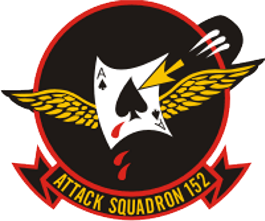
VA-152 was an Attack Squadron of the U.S. Navy, nicknamed the Fighting Aces from 1953-1956, the Friendly Squadron or Friendlies from 1957-1968, and the Mavericks thereafter.

VA-153 was an Attack Squadron of the U.S. Navy. During a 1949 reorganization of the Naval Air Reserve, a Fighter Squadron at NAS New York was redesignated Fighter Squadron VF-831. It was called to active duty on 1 February 1951. The squadron was redesignated as VF-153 on 4 February 1953, and finally as VA-153 on 15 December 1956. It was disestablished on 30 September 1977. The squadron's nickname was the Blue Tail Flies from 1953 onward.

Attack Squadron 155 or VA-155 was an 'Attack Squadron of the U.S. Navy. It was established as Reserve Attack Squadron VA-71E in 1946, redesignated as VA-58A on 1 October 1948, and redesignated Reserve Composite Squadron VC-722 on 1 November 1949. The squadron was redesignated as VA-728 on 1 April 1950, and called to active duty on 1 February 1951. It was ultimately redesignated VA-155 on 4 February 1953, and disestablished on 30 September 1977. Its nickname was Silver Fox from the early 1960s onward. It was the second squadron to be named VA-155, the first VA-155 was disestablished on 30 November 1949, while a third VA-155 was established on 1 September 1987 and disestablished on 30 April 1993.

VA-164, nicknamed the Ghostriders, was an Attack Squadron of the U.S. Navy. It was established on 1 September 1960 and disestablished on 12 December 1975.

VA-165, nicknamed the Boomers, was a long-lived Attack Squadron of the U.S. Navy. It was established on 1 September 1960, and disestablished 35 years later on 30 September 1996. The squadron operated in the region of Vietnam, Laos, and Korea during the 1960s and early 1970s. VA-165 transferred to the Persian Gulf after the 1973 Yom Kippur War, and also served near the Philippines during the late 1970s. During the 1980s, VA-165 was moved from the Middle East to Central America, particularly Nicaragua, back to Iran in the Middle East, off to South Korea, and then to the Middle East again for Kuwait. During the 1990s, the squadron worked in the United States, the Middle East, and Taiwan.

VA-215, nicknamed the Barn Owls, was an Attack Squadron of the U.S. Navy. It was established 22 June 1955, and disestablished on 31 August 1967.

VA-216, nicknamed the Black Diamonds, was an Attack Squadron of the US Navy. It was established on 30 March 1955, and disestablished 15 years later on 1 August 1970.

VA-34, nicknamed the Blue Blasters, was an Attack Squadron of the U.S. Navy. The squadron was established as Fighter Squadron VF-20 on 15 October 1943, redesignated as VF-9A on 15 November 1946, as VF-91 on 12 August 1948, and as VF-34 on 15 February 1950. It was finally redesignated VA-34 on 1 July 1955. The squadron was disestablished on 1 June 1969. It was the second squadron to bear the VA-34 designation, the first one having been renamed VA-35 in 1950.

Attack Squadron 15 (VA-15), nicknamed the Valions, was an aviation unit of the United States Navy. It was established as Torpedo Squadron 4 (VT-4) on 10 January 1942, redesignated VA-2A on 15 November 1946, and finally redesignated VA-15 on 2 August 1948. The squadron was disestablished on 1 June 1969, after 27 years of service.



